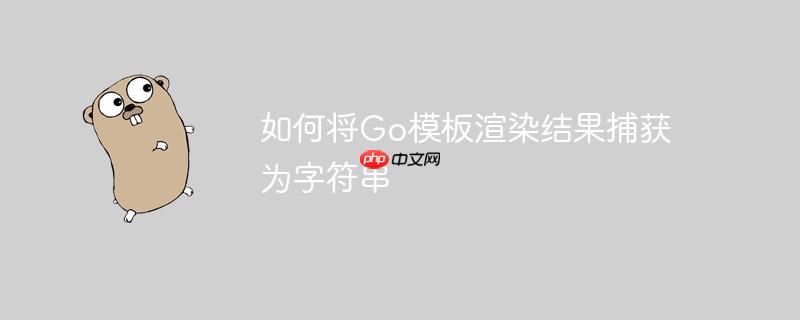
在Go语言的Web开发中,html/template或text/template包是常用的模板引擎。通常情况下,我们使用template.Execute方法将渲染结果直接写入一个io.Writer接口,例如http.ResponseWriter,以便将内容发送到客户端。然而,在某些场景下,我们可能不希望直接将模板渲染结果发送到HTTP响应,而是希望将其捕获为一个字符串或字节切片,以便进行进一步的处理、存储、日志记录或作为API响应的一部分。
设想以下几种场景:
初学者在尝试将模板渲染结果捕获为字符串时,可能会尝试自定义一个实现了io.Writer接口的类型,例如一个字节切片:
package main
import (
"fmt"
"html/template" // 注意:这里应使用 html/template 或 text/template
"os"
)
// ByteSlice 尝试实现 io.Writer 接口
type ByteSlice []byte
func (p *ByteSlice) Write(data []byte) (n int, err error) {
// 错误:这里将 *p 直接赋值为 data,而不是追加
*p = data
return len(data), nil
}
func main() {
page := map[string]string{"Title": "Test Text"}
// 假设 test.html 存在且内容如下:
// <html><body><h1>{{.Title|html}}</h1></body></html>
tpl, err := template.ParseFiles("test.html")
if err != nil {
fmt.Println("Error parsing template:", err)
return
}
var b ByteSlice
err = tpl.Execute(&b, page) // template.Execute 返回 error
if err != nil {
fmt.Println("Error executing template:", err)
return
}
fmt.Printf(`"html":%s`, b)
}
以及 test.html 文件内容:
<html>
<body>
<h1>{{.Title|html}}</h1>
</body>
</html>运行上述代码,你会发现输出结果不完整,例如只显示 "html":</h1></body></html>"。这是因为template.Execute在渲染过程中可能会多次调用其传入的io.Writer的Write方法。自定义的ByteSlice.Write方法中,*p = data的操作是赋值而非追加。这意味着每次Write方法被调用时,它都会用新的数据完全替换掉ByteSlice中已有的内容,导致最终ByteSlice中只保留了最后一次写入的数据。
Go标准库中的bytes.Buffer类型是专门为在内存中读写字节而设计的,它实现了io.Writer、io.Reader、io.ByteScanner等多个接口。它的Write方法能够正确地将数据追加到缓冲区中。因此,bytes.Buffer是捕获模板渲染结果的理想选择。
以下是使用bytes.Buffer的正确示例:
package main
import (
"bytes" // 引入 bytes 包
"fmt"
"html/template" // 使用 html/template 或 text/template
)
func main() {
page := map[string]string{"Title": "Test Text"}
// 假设 test.html 存在且内容如下:
// <html><body><h1>{{.Title|html}}</h1></body></html>
tpl, err := template.ParseFiles("test.html")
if err != nil {
fmt.Println("Error parsing template:", err)
return
}
// 创建一个 bytes.Buffer 实例
var buf bytes.Buffer
// 将模板渲染结果写入 buf
err = tpl.Execute(&buf, page)
if err != nil {
fmt.Println("Error executing template:", err)
return
}
// 通过 buf.String() 获取渲染后的字符串结果
renderedString := buf.String()
fmt.Printf(`"html":%s`, renderedString)
// 或者通过 buf.Bytes() 获取字节切片结果
// renderedBytes := buf.Bytes()
// fmt.Printf(`"html":%s`, string(renderedBytes))
}test.html 文件内容保持不变:
<html>
<body>
<h1>{{.Title|html}}</h1>
</body>
</html>运行上述代码,你将得到完整的、正确的输出:"html":<html><body><h1>Test Text</h1></body></html>。
当需要将Go模板的渲染结果捕获到内存中作为字符串或字节切片时,最佳且最标准的方法是使用bytes.Buffer。它提供了一个简单、高效且正确的方式来实现io.Writer接口,完美地满足了template.Execute的参数要求。避免自定义io.Writer时可能出现的写入逻辑错误,是确保程序健壮性的关键。掌握bytes.Buffer的使用,不仅能解决模板渲染的问题,还能在其他需要内存中构建字节流的场景中发挥重要作用。
以上就是如何将Go模板渲染结果捕获为字符串的详细内容,更多请关注php中文网其它相关文章!

每个人都需要一台速度更快、更稳定的 PC。随着时间的推移,垃圾文件、旧注册表数据和不必要的后台进程会占用资源并降低性能。幸运的是,许多工具可以让 Windows 保持平稳运行。

Copyright 2014-2025 https://www.php.cn/ All Rights Reserved | php.cn | 湘ICP备2023035733号